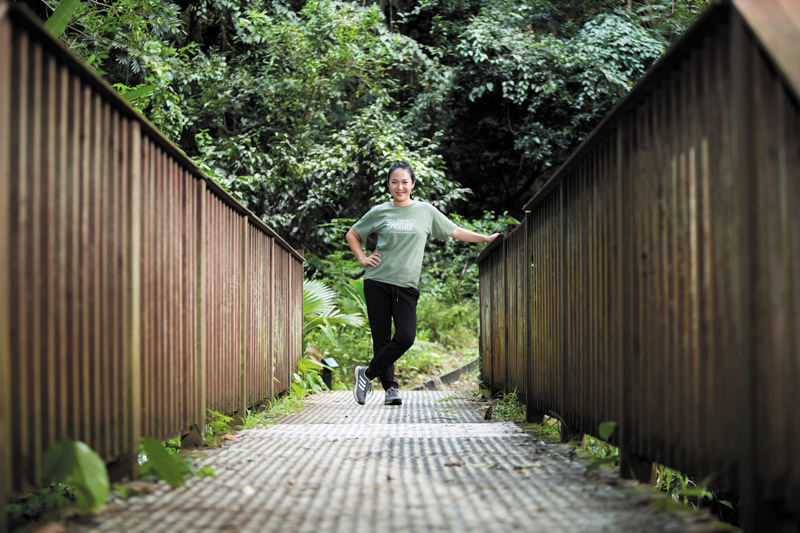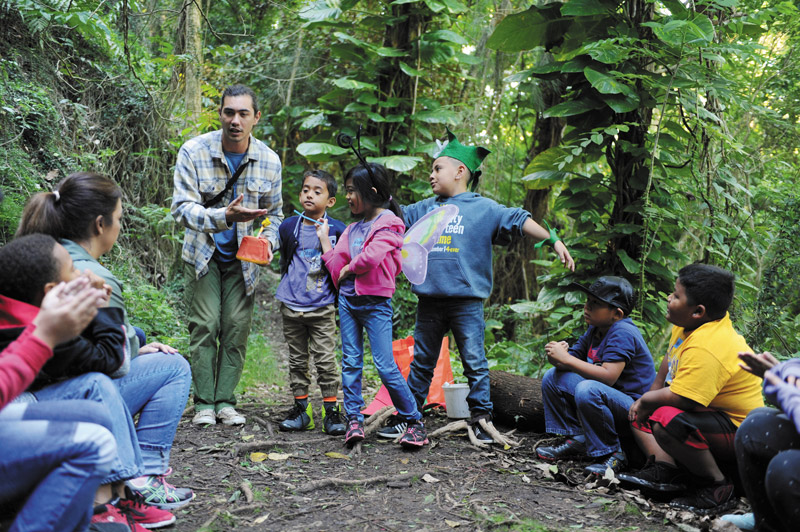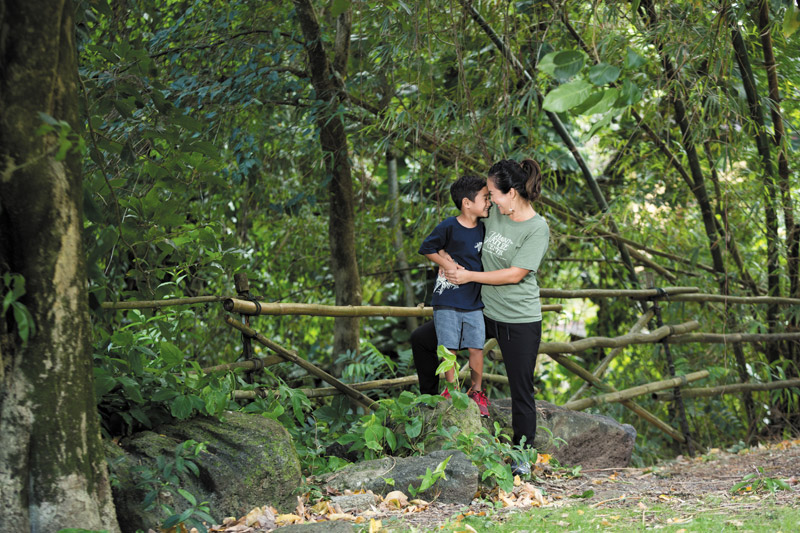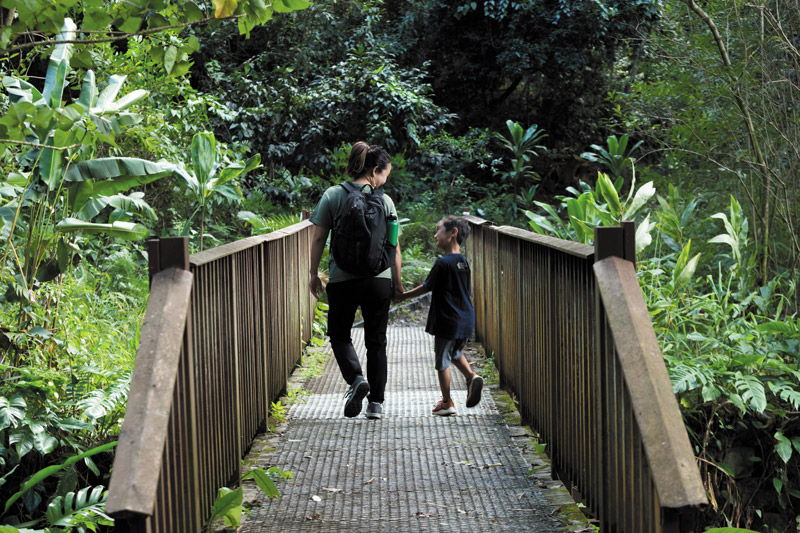Learning To Be Wise Stewards

Hawai‘i Nature Center executive director Jeeyun Lee
Led by executive director Jeeyun Lee, Hawai‘i Nature Center is ful~ lling its mission of creating greater awareness and appreciation for the environment among today’s keiki.
Jeeyun Lee leads me up metal stairs to what she calls the Green Machine. It’s an artificial wetland — in a shipping container.
And it smells like a public toilet.
Lee, executive director of Hawai‘i Nature Center, gestures toward the tank and declares, “This is where it starts.”
This “wetland-in-a-box” is, she assures me, a reasonable facsimile of nature’s own filtration system. It’s also a practical representation of what Hawai‘i Nature Center is all about — a lesson in nature’s healing and revitalizing spirit.
The reason for the stink is simple: This is, quite literally, human wastewater pumped in from the nature center’s septic system.
Lee nods. “It’s potty.”
Gross.

Environmental educator Taylor Fujimoto demonstrates how the plant cycle works to second-graders from Kalihi Uka Elementary School. LAWRENCE TABUDLO PHOTO
We walk along the outer edges of the tank. Water bubbles and flows from one semi-partitioned area to the next. Upon closer inspection, I see little fish, algae and snails, all existing and feeding off waste and native sedges, or grasses. By the time we get to the end of the huge tank, the water has been aerated and scrubbed clean. Not gross. No stink.
Lee has plans for this remarkable wetland. She wants to move it from above ground and construct it in ground. That’ll take money.
But we’ll get to that later. Hawai‘i Nature Center has campuses in Makiki on O‘ahu and ‘Īao Valley on Maui. Its mission — to “foster awareness, appreciation and understanding of Hawai‘i’s environment and to encourage wise stewardship of the Hawaiian Islands by educating children with an interactive and immersive approach.”
In other words, get the kids outside so they can experience, learn about and protect the natural world around them.
Lee takes me on a tour of the Makiki location’s outdoor “classrooms.”
“We can have up to 150 kids on campus,” she explains. “We want to get them to understand how it’s their responsibility to take care of the ‘āina — in the world and in our state.”
Understanding their connection to nature, she says, gives children a healthy outlook on life.

Thanks to Hawai‘i Nature Center’s programs and educators, Lee’s son, Kaimakana Lum, has a new outlook on the environment. “When I first started three years ago, he was literally terrified of bugs and cockroaches,” says executive director Jeeyun Lee. “… Now, he doesn’t even want to kill cockroaches because it’s not good for nature.”
Lee, 34, came to Hawai‘i from Michigan 10 years ago after obtaining her master’s in social work from Monmouth University, where she specialized in international and community development.
Hawai‘i was a good fit. “I can make a difference here,” she thought.
For years, Lee worked with the state’s most vulnerable populations, including at-risk youth and HIV-positive people. It was fulfilling. And it was intense.
As a single mom to 6-year-old Kaimakana Lum, Lee eventually decided she needed to bring more balance into their lives.
“My son was getting older, and I needed more emotional capacity to really be able to focus on raising him. I had to make sure that when I got home at the end of the day, I wasn’t emotionally exhausted from the social service work.”
But she still wanted to serve the community and to make a difference. Hawai‘i Nature Center fulfills that need.
Lee takes me to three habitats that serve as outdoor classrooms: a meadow, a small lo‘i and a stream.
The kids have fun here, and there’s a purpose behind each activity, whether it be catching bugs in the meadow, cleaning the taro patch or scooping up fish and ‘ōpae from the stream.

“We encourage them to develop inquisitive minds,” says Lee.
“In this day and age with iPhones and other things, kids are so used to being given information instead of inquiring. I think that it’s really an important and unique way for them to be exposed to looking up, looking around, and starting to ask questions.”
That sounds so basic, I tell her. Looking up, looking around?
“It is,” she responds. “But think about it, honestly. How many kids do you see sitting in front of an iPad? You go out to dinner and the kids aren’t even engaging with each other. They’re sitting next to each other staring at their phones and texting each other without even talking to each other, right?”
Right. I know adults who do the same thing.
And besides, it doesn’t hurt for the kids — and their parents — to learn that a little dirt won’t kill them, bugs are cool and not gross, and being in nature is actually fun.
“It’s absolutely amazing,” Lee says. “Some of them come with gloves! They’re afraid to touch the dirt, literally. By the time they leave they’re wet up to their knees from being in the lo‘i.”
They’re happy, tired, wet and dirty. Just the way kids should be.
“My child is 6. When I first started three years ago, he was literally terrified of bugs and cockroaches. He was just kind of risk-averse.”
But with the center’s environmental educators acting as hānai aunties and uncles and including him in the programs, “just being exposed has changed him. Now he picks up every millipede in my house and takes them back outside. Now he doesn’t even want to kill cockroaches because it’s not good for nature.”
One of those “uncles” is Taylor Fujimoto. He’s a Kalani grad and has a degree in environmental studies from the University of San Francisco. As an environmental educator at Hawai‘i Nature Center, Fujimoto handily juggles the roles of teacher, environmentalist and, because kids will be kids, entertainer.
It takes training, ingenuity and buckets of energy.
Fujimoto takes a second-grade class from Kalihi Uka Elementary through the rotations — meadow, lo‘i, stream and a nature hike — all the while emphasizing the concept of sustainability.
“Especially living in Hawai‘i,” he says, “on an island with limited resources. If you care for the land, the land will care for you.”
He emphasizes core values: respect and teamwork.
And he wants them to have fun, even as they’re absorbing the lesson of the day, which is tied to the state Department of Education’s curriculum. For second-graders, the lesson revolves around the five cycles of nature, which in case you didn’t know them are the water, animal, plant, gas and nutrient life cycles.
“I really do enjoy it. It’s fun. I get to take the kids out. A lot of them have never explored natural environments. I love seeing their faces when they get out there.”
Lee says the kids look up to Fujimoto and the other educators.
“We really want these kids to grasp the passion behind what it is that we’re doing here,” she says. “Understand that they can actually make a living doing this.
“My job is easy because I’ve never worked with such a passionate group of people before. They truly believe and embody the mission that their purpose is to get these kids to understand how they’re interconnected to the world around them.”
Hawai‘i Nature Center hosts school field trips like this on O‘ahu and Maui almost every day while school is in session.
In addition to the public and private school programs, the center offers weekly day camps called SNAP, for Sensational Nature Adventure Program, during all intersessions and over the summer.
“We also do weekend family programs,” Lee says. “I think it’s important that the agency provides inter-generation experiences, so we provide programs for kūpuna or parents to bring out their young kids and have that experience together.”
The programs, the intensive training of educators, the upkeep of land and buildings and expansion of projects require money. Lee outlines their priorities for funding:
“We’ll first be asking for a capital improvement project grant-in-aid for our water/ septic needs on both island sites and planning/permitting funds for our O‘ahu campus.”
They’re looking to upgrade and renovate their Maui site and museum space.
They need funds for the ‘Ohana Project, a pilot program that brings vulnerable youth and families out into nature for a therapeutic experience.
“My pie-in-the-sky dream would be to provide free or reduced-cost programs for everybody.”
They need to renovate their ramshackle administration building in Makiki.
And remember that wet-land in the shipping container? They aim to construct it in-ground. It’ll be not only a vehicle for teaching, it’ll also ensure that all wastewater generated by Hawai‘i Nature Center will be reused and recycled.
“It would be a better teaching model,” says Lee. “We’ll have water quality testing stations for the kids to be able to see the condition of the water when it first comes in and how clean it is as it exits.
“It’s a really important cycle. With global warming and the salination of our aquifers, it’s important for the kids to have a full understanding of the water cycle and the importance for us leaving a light footprint here in Hawai‘i.”
All of these improvements are projected to cost a little more than $3 million, which they hope to obtain with a combination of grants-in-aid and community fundraising.
And here’s a scoop: If you contribute between now and Jan. 14, Friends of Hawai‘i’s Aloha for Charities will “boost” your donation.
“You can donate now,” Lee suggests. “Aloha for Charities is connected to our donate button on our website at hawaiinaturecenter.org.”
At the end of our tour, Lee’s final message is about the center’s power to change the way young people think about Hawai‘i and their place in it.
“What I would love to have is a sustainable approach with multi-generational connections for each child from preschool all the way through high school, and to create that sense of environmental stewardship so that we can take care of this really special place that we call home.”
We wrap up our discussion while a first-grade immersion class from Waiau Elementary troops into the learning center.
As they place their backpacks along the wall, one little girl plaintively asks, “Is there any air conditioning in here?”
And so the learning begins.






